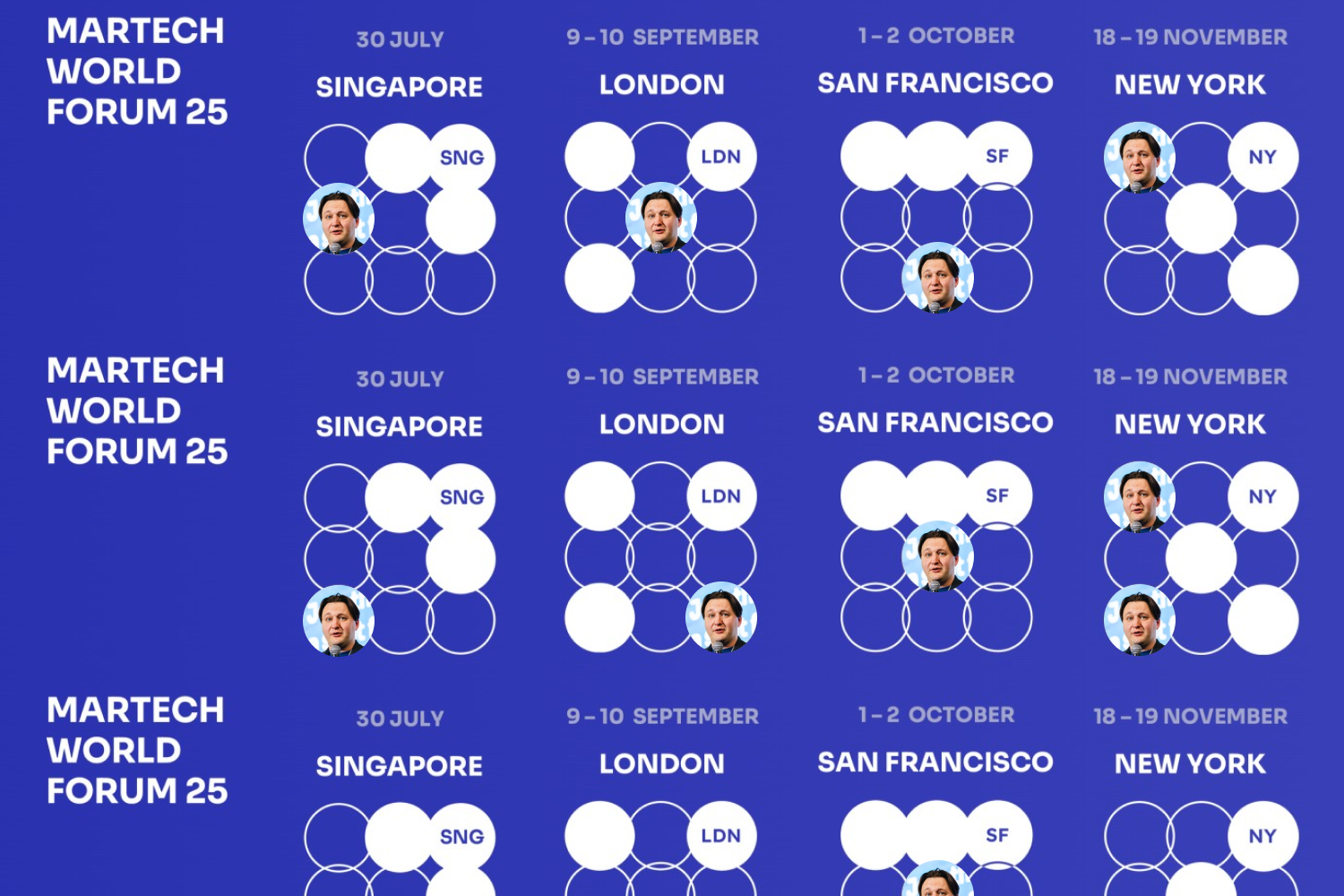Decoding Martech complexity: Juan Mendoza on founding TMW and the future of the industry

The Martech Weekly: origin story
Could you share how your journey in marketing technology began and what led you to found The Martech Weekly?
My path started somewhat accidentally. Before founding The Martech Weekly (TMW), I worked in various roles, from startups doing simple marketing operations – connecting Shopify to Mailchimp, using APIs, lots of Google Sheets – to eventually spending a good six years in enterprise martech consulting here in Melbourne. My job involved going into large companies – airlines, banks, retailers, nonprofits – and helping them figure out their martech strategy.
What struck me almost immediately was the sheer complexity, not just in the technology itself, but within the organizations. There were silos between departments, competing incentives, and constant challenges just making the technology work for the business. The marketing tech leaders I worked with felt constantly blocked by politics, data silos, and technology limitations. Even simple campaigns could become incredibly complex. I remember one large insurance client where it took a team of eight people – delivery managers, email developers, brand coordinators, data suppliers dealing with ancient architecture – just to send out two basic emails a week. That level of complexity hindered what marketing technology could truly achieve.
Yet, on the other hand, I saw the immense potential. Another large travel client implemented a simple personalization project that took maybe six to eight weeks and added five million dollars in incremental revenue annually. So, I witnessed both the incredible power of martech at scale and the frustrating blockers preventing companies from getting things done. My role often involved setting strategy, creating a vision, and building roadmaps to deliver value, ensuring the discipline to stick to it despite the organizational chaos.
What specific gap did you identify that sparked the idea for The Martech Weekly?
Amidst all that complexity and potential, I realized that many people working within these large consumer brands had very little visibility into the broader martech landscape. They didn’t know who was acquiring whom, which vendors were truly innovating, the latest regulatory changes, or how to sift through the hype around trends like blockchain, the metaverse, or AI. Enterprises are the holy grail for tech vendors, but the people inside often struggled to navigate this rapidly changing space.
The missing piece was a resource to help these complex organizations understand what was actually changing in the market and how martech could help them respond. That’s what really set me on the journey. TMW started as a way to solve my own problem – I wanted better visibility myself. I began writing a weekly post on LinkedIn, calling it The Martech Weekly because it was simple and reflected the goal: talk about martech once a week. Writing forced me to research, learn, and clarify my own thinking, which in turn made my consulting work much better. It was like falling in love with writing; I went from 300 words a week to 3,000, spending my Sundays analysing the industry.
How did that personal project transition into a full-fledged business?
The LinkedIn posts gained traction surprisingly quickly. When I eventually created a formal subscription list, about 100 people signed up within the first hour. Over three years, while building TMW during nights and weekends, it became clear there was a real market segment – enterprise marketing technologists, especially on the consumer side – that was poorly served. They lacked dedicated resources for research, insights, and community tailored to their complex needs.
Based on feedback from subscribers, we launched TMW Pro, a paid subscription offering deeper research and analysis. That gained quick adoption, providing the seed capital to turn TMW into a real business about two years ago. From there, we added the TMW 100 innovation program and the Martech World Forum global event series, driven by our community’s desire to connect and learn from genuine, often unheard, thought leaders – not just the big names you see everywhere. Now, we’re a team of ten spread across the globe, growing fast, and still focused on serving that enterprise niche that needs support navigating the complexity and potential of martech. We’ve also launched research programmes, vendor analysis projects and advisory memberships.
The state of Martech & the rise of composability
Based on your conversations and research for TMW, what are the major pressure points or shifts you're seeing in the martech industry right now?
One of the biggest themes is this push and pull between tactical execution and strategic thinking. Marketers are getting pulled into the weeds of campaign management, but the real value comes from understanding the bigger picture. Are the channels we rely on today, like Google Search, going to be viable in five years with generative AI changing everything? Will email remain dominant, or will privacy changes and platform shifts make it less reliable? These strategic questions often get lost in the day-to-day grind.
Another key pressure point is career development within martech. People invest years becoming experts in specific tools, like Marketo or Salesforce, only to find the landscape shifting underneath them. I spoke with a Marketo super-user at a major company who realized, after 15 years, that hyper-specializing in one platform was limiting his future career options, especially as email becomes more centralized by major tech players. He proactively sought a broader role to expand his skillset. It’s a real challenge – how do you stay valuable when the tools you master might become obsolete? It requires marketers to think more strategically about their skills and hedge their bets.
Then there’s the data silo problem, which is massive, especially in the enterprise. Technology often enforces these silos rather than breaking them down. Marketing has its data, product has its data, engineering has its data, and they often don’t talk to each other effectively. This hinders personalization and prevents a unified view of the customer.
You mentioned data silos leading into the idea of composability. How did that trend emerge, and why do you see it as revolutionary?
The composability trend really gained steam around 2021-2022, but the trigger point was arguably Twilio acquiring Segment. That acquisition released a lot of talented people into the market, including the founders of Hightouch. They saw that while Segment was battling traditional CDPs, its real competition was companies building their own customer data platforms internally, often on top of cloud data warehouses like Snowflake or AWS. Many sophisticated retailers and tech companies had already built their own CDPs because the packaged solutions didn’t meet their needs or integrate well with their existing data infrastructure.
Hightouch came along with the idea of a cloud-native, composable CDP – one that doesn’t store data itself but activates data directly from the company’s central warehouse. Initially, I was skeptical. I thought the value of packaged CDPs was their marketer-friendly interface, a sandbox where non-technical users could segment and activate data without needing SQL or IT’s help. I worried composability would make things harder for marketers.
But I was wrong. My mind changed when I saw firsthand how traditional CDPs create vendor lock-in. A large streaming client using a packaged CDP was told they’d have to pay an extra $20,000 a year just to integrate their CDP customer profiles with their AWS data warehouse for their data science team. That’s when it clicked: CDPs, by storing and controlling the company’s most valuable asset – their customer data – become the ultimate lock-in strategy. Leaving them is incredibly painful and costly, sometimes causing 20% staff turnover. The interface and identity resolution you rely on are owned by the vendor. Why pay extra to access data you already own?
Composability flips that model. It leverages the central data warehouse as the source of truth, breaking down silos between marketing, product, and engineering. It allows companies to use best-of-breed tools for activation without being locked into a single vendor’s ecosystem. It keeps vendors honest, forcing them to compete on product value, not just lock-in. That’s why we called our research the Composability Revolution – it’s a shift in philosophy towards a more open, flexible, and marketer-empowering tech stack.
Enterprise Martech challenges
You mentioned the pain points enterprises face with vendor lock-in from traditional CDPs. How are those incumbent players reacting to the rise of composability?
It’s a classic innovator’s dilemma situation. Many established CDP vendors recognize the composable trend, but disrupting their own business model is incredibly difficult. I’ve been in conversations where vendors admitted that going fully composable – meaning not storing customer data themselves but integrating directly with a client’s data warehouse – would wipe out potentially 50% of their revenue overnight. That revenue often comes from data storage and the professional services required to manage and integrate that siloed data. Making that shift would mean mass layoffs and a complete business model overhaul, which is a huge risk for established players.
So, while some incumbents like Twilio Segment, mParticle, ActionIQ, and Bloomreach are launching composable features or integrations, they’re often trying to balance it with their existing model. They can’t fully abandon the lucrative data storage and services component that locks customers in. This creates an opening for newer, cloud-native players like Hightouch, Growthloop, and others who built their architecture composably from day one. They can often compete aggressively on price because the customer already pays for data storage in their own warehouse (like Snowflake or AWS), and the composable vendor just provides the activation layer.
If the future involves activating data directly from cloud warehouses, what's stopping platforms like AWS, Google Cloud, Oracle, or Snowflake from building these marketing activation layers themselves and cutting out the composable vendors?
That’s a really important question. I’ve wondered about this myself, especially why Snowflake or Google Cloud don’t seem more interested in building deeper marketing and advertising use cases directly onto their platforms. The primary reason seems to be the value versus risk equation, particularly concerning data privacy and trust.
These cloud giants handle incredibly sensitive data for major clients in healthcare, finance, insurance, legal, and other regulated industries. Their core, (and more lucrative) business relies on guaranteeing absolute data security and privacy. Building native advertising activation tools on top of that same infrastructure poses a significant perceived risk. Even if the data is technically separate and secure, the perception that customer or patient data could potentially be used or exposed for advertising purposes is enough to scare away large enterprise clients in sensitive sectors.
We saw this play out with Oracle. They completely decommissioned their ad tech division, including acquisitions like BlueKai (a DMP), largely because it was hurting their ability to win deals in privacy-sensitive industries. Clients couldn’t fully trust that data stored in Oracle Cloud wouldn’t somehow bleed into their advertising products, despite assurances. The fines and reputational damage from a major breach involving sensitive health or financial data would be catastrophic, not just for the cloud provider but for their clients too.
Therefore, it seems more valuable and less risky for the cloud providers to foster a partner ecosystem built on top of their platforms rather than building these marketing tools themselves. They benefit from usage credits and partnerships – like Optimizely integrating natively with Google Cloud and customers using credits to pay – without taking on the direct risk associated with activating sensitive data for marketing. Building a thriving partner ecosystem seems to be the more valuable long-term play for them compared to the risk/reward of owning the marketing activation layer directly.
AI in Marketing & The Martech Weekly Ecosystem
Looking ahead, how do you see AI and large language models (LLMs) reshaping the role of the marketer and the tools they use?
It’s a great question and something we’re exploring deeply. There are huge opportunities but also significant challenges. On the opportunity side, I think LLMs could fundamentally reset marketing interfaces. If you look at most SaaS tools today, the interface hasn’t changed much in decades – it’s often menus, tables, lists, maybe a workflow builder. It’s not far from Excel, which is ancient! LLMs offer a different way to interact, not just with data like in Amplitude where you can prompt for a report, but potentially with your entire marketing workflow. Imagine asking questions, getting insights, and even executing tasks through a conversational agent instead of clicking through complex UIs. It’s a canvas for experimentation. That’s exciting because interfaces frame our reality and how we approach work.
However, there’s a challenge I call the rise of the “impotent marketer”. Sam Harris, a prominent AI and ethics philosopher, had this thought experiment about self-driving cars: if AI drives everything, humans lose the skill to drive, and it might even become irresponsible for them to try. You can apply that to marketing. If AI agents, like Salesforce’s Agentic capabilities or others, start doing all the campaign setup, copywriting, automation, and even strategic thinking for us, marketers could become disempowered. They might lose the critical skills and deep understanding that comes from doing the hard work themselves. Will marketers simply prompt an LLM and let it handle everything? It’s more convenient, maybe more efficient initially, but it erodes the craft and the joy of marketing – the creativity, the problem-solving, the learning.
Where do you see the limit? How much will marketers trust these AI systems?
That’s the core question. I talk to many AI vendors, and the trust barrier is real. If you’re a Head of Martech or Performance Marketing responsible for hitting a multi-million dollar revenue target, can you truly hand over accountability to an AI? You can’t blame the AI if things go wrong; it’s not a person, it can’t take responsibility. Businesses will always want a human to be accountable, at least in our generation.
I suspect the limit will be at the tactical level. AI will likely excel at experimentation, A/B testing variations, optimizing campaign settings, channel selection based on data analytics – the operational tasks. But strategic thinking, setting the vision, defining the brand, understanding nuanced customer psychology – that will probably remain human territory. That said, there’s immense pressure from executives to adopt AI, often without a clear strategy, and sometimes AI projects are just a way to get budget for necessary but unglamorous work like data cleansing. It’s a complex dynamic.
Bringing it back to The Martech Weekly, how does your platform and community help marketers navigate this evolving landscape?
Our core mission is to provide clarity and support for B2C enterprise Martech leaders that are managing massive complexity at scale. We do that through our research and content – like the Composability White Paper – giving leaders frameworks and data to make better strategic decisions. Our paid subscription, TMW Pro, offers deeper insights for teams wanting to stay ahead.
The Martech World Forum event series is also crucial. We deliberately create intimate settings in cities like London, New York, Singapore, and others, focused on genuine connection and access to original thinkers – people you might not see on the main stages of huge conferences. It’s about building real relationships and hearing unfiltered insights from practitioners and thought leaders like Aaron Spinley, who reframed marketing tech’s role as managing the crucial customer data asset. We’re expanding events too, adding more cities. Ultimately, whether it’s through the newsletter, research, events, or our upcoming advisory service, we aim to be the trusted resource helping martech leaders tackle complexity and drive real value. We love getting feedback and connecting with the community.

Martech 2025: Scott Brinker on new data paradigms & AI’s next act
Scott reveals insights from his state of martech 2025 report and what it takes to build successful marketing ecosystems...